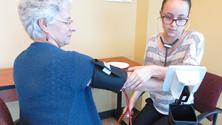What is an Isolated Practice?
An Isolated Practice is set apart geographically or isolated in terms of the nature of their practice or patients they serve. Frequently, they are without robust administrative resources due to staffing shortages, and may not have access to guidelines that apply to their specific population or organizational environment. It also can be hard for them to connect with similar practices, making it difficult to share best practices for their community. Additionally, they cannot always provide patients with specialty services that are only offered in large health systems or metropolitan areas. Despite these challenges, their staff often work at the top of their licensure and have opportunities to develop skills that would not be possible in larger health systems. An isolated practice might be an independent, rural, tribal, faith-based, or transient-based practice or an FQHC.
Example from a practice facilitator:
This Isolated Practice was a clinic based in a rural location with only five staff and one clinician providing care. The clinic struggled with efficiency and supporting personnel to work at to the top of their licensure, which was something the practice needed to optimize their limited staffing resources. They used the Healthy Hearts Northwest initiative to implement elements of team-based care, including certifying all medical assistants, expanding roles and responsibilities, and transforming how patient care was delivered in their practice. They conducted continuous quality improvement activities to work better as a team and to connect patients more closely with all staff and clinicians, ultimately leading to changes in clinic structure and care redesign.
Data
The practice does not have the processes or skillset to interpret what the data indicate about their practice.
This practice may have rudimentary knowledge of their process and outcome data, but they do not systematically monitor or engage with the data meaningfully or fully understand the existing issues that could affect how the data are interpreted. Based on their earlier work, this practice may already look at data reports regularly or have dashboards for their clinicians, but there are problems understanding the implications.
Strategies
The practice facilitator can help the practice look at the data they currently generate and ask them to explain what it means and how they act upon it. Look at reports for two or three measures that are a shared priority among the staff, and start a conversation about what concrete steps might be taken in areas they want to improve upon. Discuss what would be a reasonable goal for the practice. Encourage staff to tie overall data trends back to individual patients they know and consider how they might be able to support a patient who is not currently meeting a metric. Help the practice interpret their performance by benchmarking their data with other settings using data available from external registries to understand what is being done in locations with similar patient populations, EHRs, and practice delivery models for shared learning.
The practice has difficulties accessing and/or refreshing data to guide improvement.
The practice has issues capturing and/or systematically updating the data it needs to drive change. Practice staff may have rudimentary knowledge of where their process and outcome data comes from, but they have no ability to routinely refresh or upload information to their EHR so they can understand their data and act upon it. They often lack an in-depth understanding of data sources and definitions, which raises issues involved in its interpretation. Practices frequently underestimate the effort required not only to incorporate the EHR into the practice workflow for patient visits, but also to utilize EHR data to drive improvement. Without effective workflow integration, it is difficult for practice staff to use the EHR for quality improvement due to missing data or data not being captured in the correct templates during the patient visit. It is common for this type of practice to have inaccurate reports, which cannot be effectively used for quality improvement.
Strategies
Practice facilitators can increase the practice’s understanding of how data flows through the EHR system and the basics behind clinical quality measurement reporting and metric definitions. Help guide practices to create a patient population list, which can be produced in most certified EHRs that support clinical quality measures reporting. Help staff produce patient lists from the metrics such as “patients not compliant” or “numerator misses.” Encourage them to start small - look up about five patients on the list to see if they are appropriately placed on the list and identify gaps in the data capture or gaps in patient care. If necessary, help the practice engage with external registries such as PRIME to have greater capacity to monitor and identify patients and care gaps. If possible, it is also helpful to connect practices that have similar patient populations, EHRs, and practice delivery models for shared learning.
Self-Management Support Materials
The practice does not have up-to-date patient self-management materials.
This practice frequently has outdated or limited (in terms of supply and/or detail) patient self-management materials. Especially for settings that serve a distinct population, the ability to identify evidence-based and culturally relevant materials can be a challenge. Additionally, locating appropriate materials and making them accessible to staff can be very time consuming, and thus, often results in the patient having to rely on their recollection of the conversation they had with clinical staff regarding their appointment.
Strategies
The practice facilitator should listen to the practice staff to understand the patient population and the needs of the surrounding community. Research examples of current and relevant materials, and help the practice test their use with a few patients and patient family members to discover what works best for both. Once patient materials are selected, help the practice determine the best way for them to obtain and store needed quantities in the correct languages and develop relationships with the sources to procure ongoing updates.
As an example, state-run smoking cessation programs will send practices pamphlets with phone numbers and websites patients can contact directly. Help practices connect to appropriate training resources for clinic staff to learn skills such as lifestyle coaching, diabetic education, motivational interviewing, care management, and other proven methods for improving patients’ self-management skills. One benefit of documenting and utilizing available community organizations is that it can help direct patients to local resources such as fitness centers or community centers.
The practice does not have up-to-date patient self-management materials.
This practice frequently has outdated or limited (in terms of supply and/or detail) patient self-management materials. Especially for settings that serve a distinct population, the ability to identify evidence-based and culturally relevant materials can be a challenge. Additionally, locating appropriate materials and making them accessible to staff can be very time consuming, and thus, often results in the patient having to rely on their recollection of the conversation they had with clinical staff regarding their appointment.
Strategies
The practice facilitator should listen to the practice staff to understand the patient population and the needs of the surrounding community. Research examples of current and relevant materials, and help the practice test their use with a few patients and patient family members to discover what works best for both. Once patient materials are selected, help the practice determine the best way for them to obtain and store needed quantities in the correct languages and develop relationships with the sources to procure ongoing updates.
As an example, state-run smoking cessation programs will send practices pamphlets with phone numbers and websites patients can contact directly. Help practices connect to appropriate training resources for clinic staff to learn skills such as lifestyle coaching, diabetic education, motivational interviewing, care management, and other proven methods for improving patients’ self-management skills. One benefit of documenting and utilizing available community organizations is that it can help direct patients to local resources such as fitness centers or community centers.
Incorporation of Evidence
Clinicians and staff may not be aware of the most recent evidence-based care guidelines.
The practice’s clinical teams rarely discuss treatment protocols or share their personal approaches, so each team functions as an island, without opportunities to learn from each other or share new evidence. These practices tend to have either very high turnover in clinicians or be the domain of a solo practitioner who relies on their personal experience and training, which may have taken place some time ago. Practices that are more geographically isolated, such as in rural settings, may not have processes in place to identify and share the latest evidence-based care, and may also have fewer opportunities to interact and learn from other community practitioners.
Strategies
Culture
The practice often has only one person “leading the charge,” and the team disagrees about the importance of quality improvement activities.
This practice may have a dedicated staff person for quality improvement activities or a clinical champion that spearheads quality improvement work. In many cases, this individual operates in isolation and may distrust getting input from other members of the team. In other instances, it is a staff person who has many other responsibilities and does not have adequate time to dedicate to quality improvement. Frequently, this team is not communicating internally to be fully aware of all the efforts occurring across the various team members and roles within the practice.
Strategies
Data
148Incorporation of Evidence
150Self-Management Support Materials
151Culture
152If you have a question about the improvements, action steps, or tools & resources in this module please let us know. We're here to help. And if we can't answer your question, we can probably connect you with someone who can.




